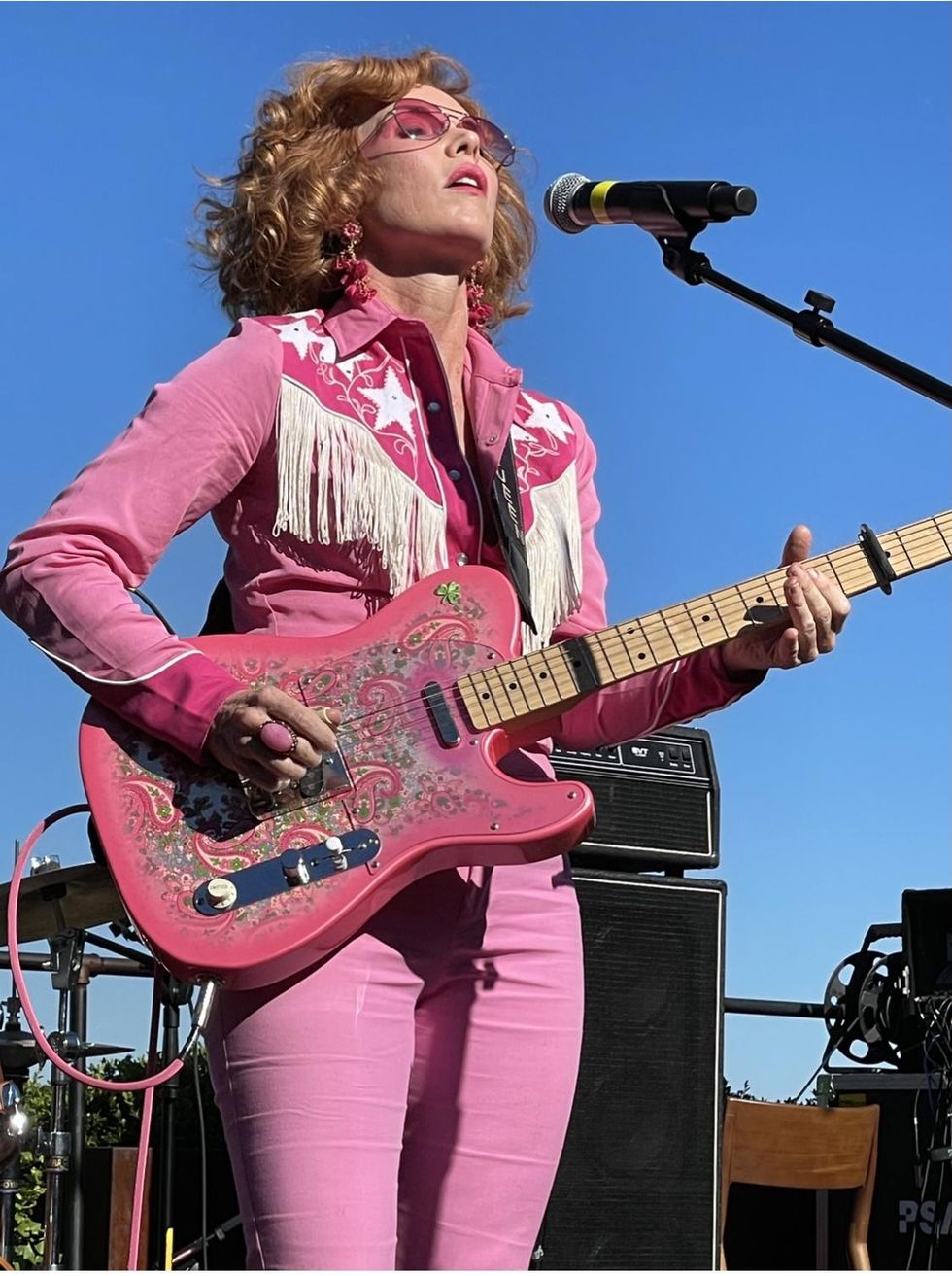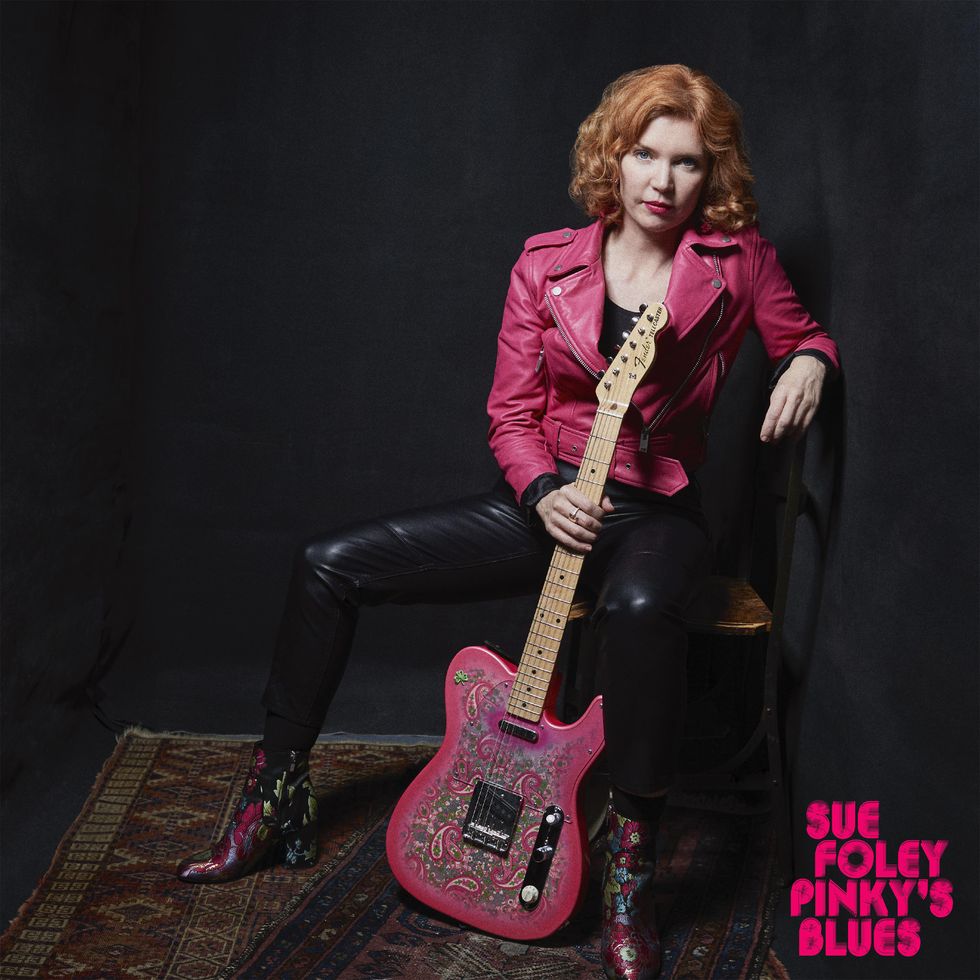For Austin, Texas’ favorite Canadian expat, guitarist, and singer Sue Foley, staying faithful to the blues tradition is more than just a concern of style. It’s a calling. Foley explains: “I never questioned really dedicating myself to the blues, and that commitment and desire to always be true to it has never changed. I can see where the lines have been blurred between blues, Americana, and country, and there’s a million ways you can skin a cat at this point, but for me and my perception of what the blues really is, you have to step into a history and a deep tradition.”
With her latest release, Pinky’s Blues, Foley doubles down on that assertion while adding a fresh document to Austin’s fabled blues catalog. The album’s obscure song selections flex Foley’s muscles as a historian and student of the form, but also provide a fabulous platform for her tremendous personality and chops as a guitarist and vocalist. The album, which was named after her beloved late-’80s pink paisley Fender Telecaster, “Pinky,” is Foley’s 16th release as a leader and a love letter to the forgotten but influential deep cuts that helped shape the Austin blues sound as we know it.
“We really handpicked these tracks of favorites between me and our producer Mike Flanigin. These are all songs that, when we were coming up, you kind of had to know to get in the club, so to speak. Something like Clarence ‘Gatemouth’ Brown’s ‘Okie Dokie Stomp’ was a rite of passage for any guitar player in Austin back then. Now, you never hear anyone doing it, but it was a regular song that everyone had to know.”
Pinky's Blues
Foley earned her stripes in the blues world the old-fashioned way. After starting to find her voice on guitar in her native Canada, she grew enamored of the blues and specifically the sounds coming out of Austin. Foley relocated to the hip Texas city in the early ’90s to immerse herself in the local blues culture. In an era before the internet gave us infinite access to all things, Foley’s Texas pilgrimage wasn’t just a drastic way to soak up the music. It was the most authentic way. Foley ruminates on that magical, pre-internet era.
“It’s completely different now! I have a 24-year-old son that’s a musician, and the way he is able to view and experience music is totally different from what we did. It’s still really valid, but it’s just a different vibe. What I saw and experienced was all direct transmission, and that honestly had to be experienced directly. I had to stand in front of Albert Collins’ amp to get the full effect! I had to have part of my hearing destroyed and I had to move molecules. I think direct transmission like that is important and you just can’t get that from the internet.”
“Let’s face it, Howlin’ Wolf wasn’t in there splicing together his vocal takes.”
Foley continues: “I can talk about Albert Collins, but unless you stood in front of his amp and watched him, you can’t really get it. You can watch all the clips of him you like and say, ‘Well, yeah, he had a wicked tone,’ but when that tone hit your ears in person, I’m telling you it split your hairs! That shit was real and that shit changed my life. I’m not sure if I was just starting out today if I’d even be a blues musician, because I wouldn’t have seen all of these people live. It was experiencing that face-to-face and walking away with my jaw dropped that changed my life and expanded my spirit and my soul, and I’m not sure I could do that watching a YouTube video.”
The years Foley spent worshiping in front of the amplifiers of (and eventually sitting in with) greats like Collins, Brown, Billy Gibbons, and Jimmie Vaughan helped her shape a style that’s undeniably authentic and traditional, but defined by an impressively vocal phrasing approach that gives her playing its own special personality. From the soulful, improvised instrumental title track and album opener to the brasher rave-ups (“Dallas Man” and “Okie Dokie Stomp”), Foley’s singing and guitar playing is timeless and familiar, yet entirely her own. From her tones to her note choices, she tends to favor understatement fueled by palpable conviction.
Sue Foley’s Gear

Meet Sue Foley’s pal Pinky, the reissue Telecaster that’s been her onstage companion for 30 years. She strings the instrument with D’Addario .010 sets and uses a thumbpick for her ringing single-note leads.
Photo by Michele Gare
Guitar
- 1988 Fender MIJ ’70s Paisley Telecaster Reissue named Pinky
Strings & Picks
- D’Addario strings (.010–.046)
- Golden Gate small thumbpicks
In the spirit of capturing as live and visceral an experience as possible, Pinky’s Blues was cut in just three days by Foley and her band (which included drummer Chris “Whipper” Layton of Stevie Ray Vaughan and Double Trouble/Arc Angels fame, and a guest appearance from Jimmie Vaughan himself) playing in the same room—including all the amps. There was no pre-production involved and the musicians went in with only a cursory knowledge of the songs—something Foley believes added a lot to the album’s undeniable spark and energy.
“Everything was done live, everything was played together in the studio, including the vocals,” Foley relates. “No overdubs. I was just getting comfortable with a few of the songs. Chris Layton is obviously a wizard and can just play anything, and Jon Penner was my very first bass player and he’s back in my band now. So, it was a bunch of really skilled musicians and what we do is live music, so none of us were intimidated by the process. We just went for it! That’s how all our favorite albums were cut! Let’s face it, Howlin’ Wolf wasn’t in there splicing together his vocal takes.”
From Foley’s perspective, deliberately shirking any rehearsal of the tunes on Pinky’s Blues forced her and her band to really listen to one another as they tracked. “Everyone was really in the moment, and that spontaneity and energy is what you’re hearing on the album. And the reason this album sounds so good is the bleed, because we had so many room mics and we were all in one big room. It was set up like a live show and we just hit record, so we were getting the drums in the vocal mics, the vocals in the guitar mics, and that bleed created this big, cohesive sound. Our engineer, Chris Bell, worked hard to get those sounds right, and I know he had challenges mixing the album because everything is going into everything. You want a blues record to be a little on the edge, you know?”

Recorded in the studio in just three days, Foley’s new album sparkles with live energy—and bleed. Producer Mike Flanigin is also an Austin scene stalwart, who has toured and recorded with Jimmie Vaughan and Billy Gibbons.
When asked what legendary drummer and longtime friend Layton brought to the fold beyond his signature deep pocket and greasy backbeat, Foley is quick to call out his fantastic playing on “Southern Men,” and tells PG the tune was a deep cut that was dug up from an obscure ’70s compilation album called Blues in D Natural. “I’ve had it in my vinyl collection from way back, and Chris Layton had that same compilation and showed it to Stevie [Ray Vaughan] and they cut [Sly Williams’] ‘Boot Hill’ off that album. The original version [by Georgia-based bluesman Tommy Brown] was called ‘Southern Women,’ but we did it as ‘Southern Men.’”
All players hit a rut occasionally, and when Foley found herself in the 6-string doldrums, she turned to flamenco guitar to shake things up. Foley believes the picking hand is where the magic of a player’s personality really comes through, and as a player with a fixation on picking techniques, flamenco offered her a buffet of new techniques and a completely alien playing experience. Foley, who favors a thumbpick and acrylic nails on her right hand, says, “I used to watch Gatemouth, and his picking hand had this magic thing to it. He had unique things he was able to do. I took flamenco lessons because there happened to be a teacher in town, and it really turned me on my ear. It was literally like I had never played the instrument before, and I had been playing for almost 20 years at that point. It was very humbling. I took a year or two of those lessons and I applied those techniques to some kind of hybrid-blues form. I love playing my nylon-string guitar, and flamenco and blues are very sympatico art forms in my opinion. I think a lot of your tone comes out of the picking hand and I think you get more special elements out of your playing if you focus on that side of your playing a bit more.”
“These days, the whole loud guitar and amplifier thing isn’t the most popular thing, but it still is for me, and I love it. It’s a feeling of power!”
Much like her heroes, Foley favors a lone guitar and a spartan rig. The entire album was tracked with Foley’s paisley Telecaster named Pinky, which is a stock MIJ reissue that she fell in love with and got new in 1988. “I saw it and thought, ‘I have to have that!’ and my boyfriend at the time brought it home for Christmas and had made the first payment, but I paid it off in installments,” Foley says of Pinky’s origins. “I’ve played that guitar at every show, recorded every album, and done every tour with it for 30-something years now. It’s got a lot of miles and it still sounds great. I’ve never changed the pickups, but I’ve had it refretted a few times. I’ve always loved the neck and it’s always sounded so good that I’ve just never wanted to mess with it!”
Pinky sang through an early ’90s 1959 Fender Bassman reissue on the album, which Foley bought new. The guitarist says that she’s never felt the need to be particularly adventurous about gear, because “you can dress everything up, but at the end of the day, you’re still you and you’re going to sound like you. When I saw Albert Collins, he only ever had one guitar. When I saw Gatemouth, he almost always played the same one.” However, Foley does make an exception for reverb, which she loves, and called upon a Boss Digital Reverb and a Strymon Flint to add some atmosphere to her cranked Bassman.

Foley digs into one of her solos, which are marked by a thick midrange-and-reverb heavy tone and in-the-pocket playing.
Photo by Joseph A. Rosen
Beyond her killer new album, Foley’s many years in the game—coupled with a dedication to studying the blues tradition with an academic approach—has afforded her a unique perspective. While she’s a staunch proponent of preservation, Foley makes no bones about the fact that to keep the blues alive “you have to breathe new life into it, you’ve got to be yourself, and you’ve got to tell your story. There’s a whole bunch of things you can add into it that bring this tradition forward and into the current times, but it’s about your personal story and nobody can take that away from you. That’s where your blues begins and ends, really!”
Foley’s lengthy career has brought her shoulder-to-shoulder with some of the greatest guitarists the genre has ever produced—experiences she says were not just wildly validating but provided the perfect opportunity to steal from the best. “You can learn some of their tricks because you’re seeing them up close and getting a feel for the little special things that everybody incorporates in their stuff that might not be immediately apparent,” she notes. “I’ve played with Jimmie [Vaughan] a lot, and he’s got a lot of little special things that he does to make up his secret sauce, so there’s that. That osmosis and direct transfer and those magical things that shoot right into your spirit when you’re getting them from an amp and a guitar … that’s what it’s all about for me. These days, the whole loud guitar and amplifier thing isn’t the most popular thing, but it still is for me, and I love it. It’s a feeling of power!”
And while many of the great blues players that shaped her love of the genre have now passed on, Foley still appreciates the style’s capacity for reverence and respect for its elders more than anything: “When I was coming up, we toured with every blues artist that was on the scene, from Buddy Guy to Koko Taylor. Most of them were a lot older, but there was a real reverence for that age and a real respect, and I just love that about the blues. You can grow up in it, grow old in it, and get better! To me, that was always the beauty of blues music: When you get older, you kind of get better. It’s such an age-obsessed, youth-obsessed world these days and when you see an art form like this that not only really appreciates age, but you kind of have to have some years in the game to be the real deal … it’s rare.”
Sue Foley - Live in Europe DVD
Chock full of perfect-blues-tone guitar solos, this live concert from Köln Germany captures Sue Foley relatively early in her relationship with Pinky, her paisley Telecaster. It also reveals how deeply her playing is rooted in Austin’s blues legacy.
















![Rig Rundown: Russian Circles’ Mike Sullivan [2025]](https://www.premierguitar.com/media-library/youtube.jpg?id=62303631&width=1245&height=700&quality=70&coordinates=0%2C0%2C0%2C0)








